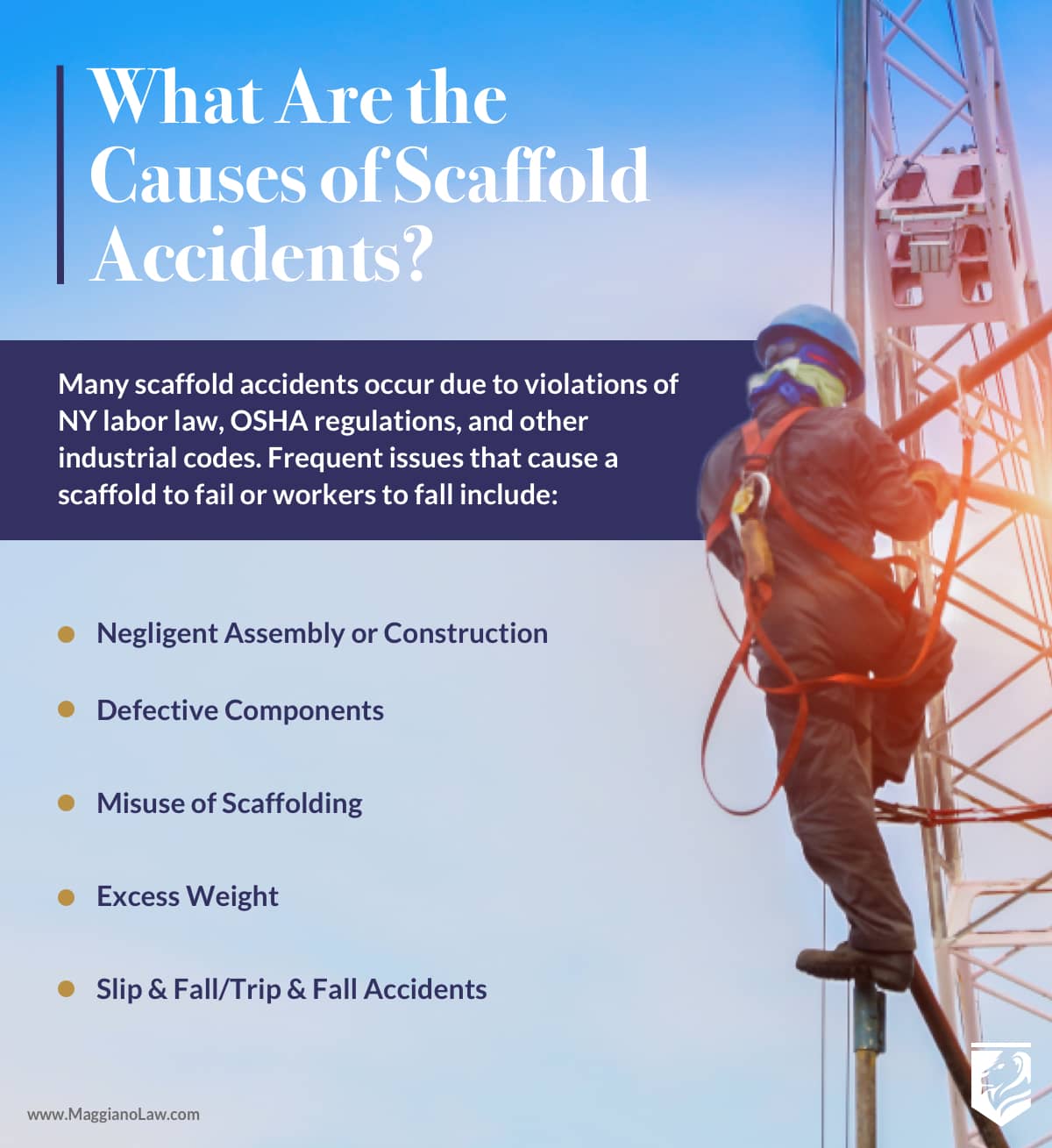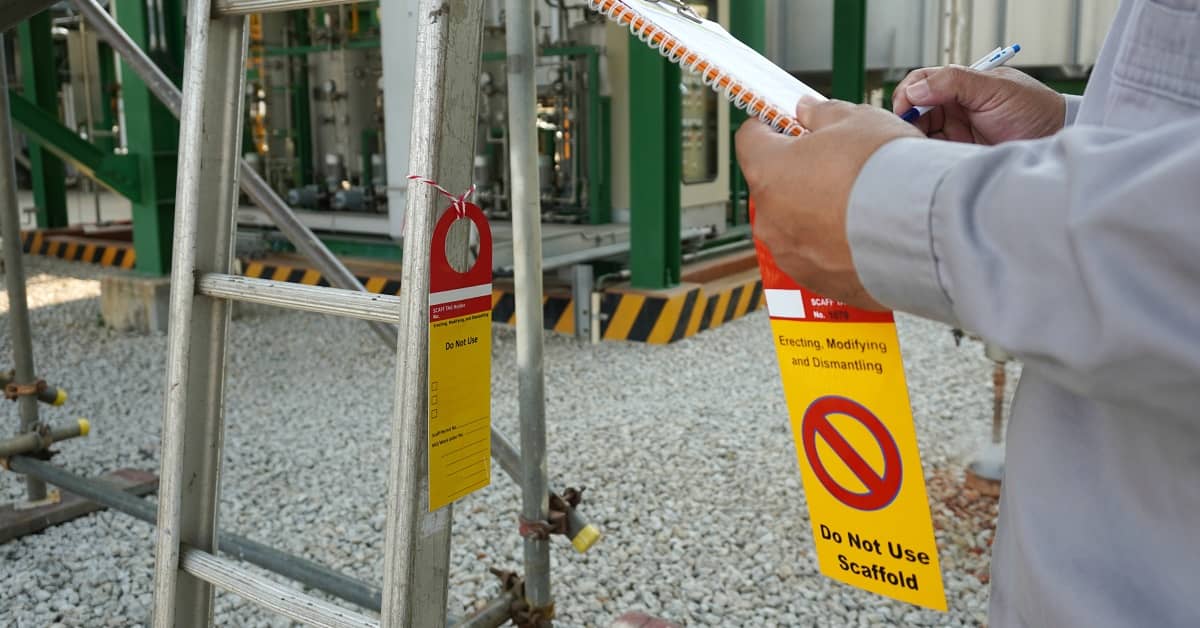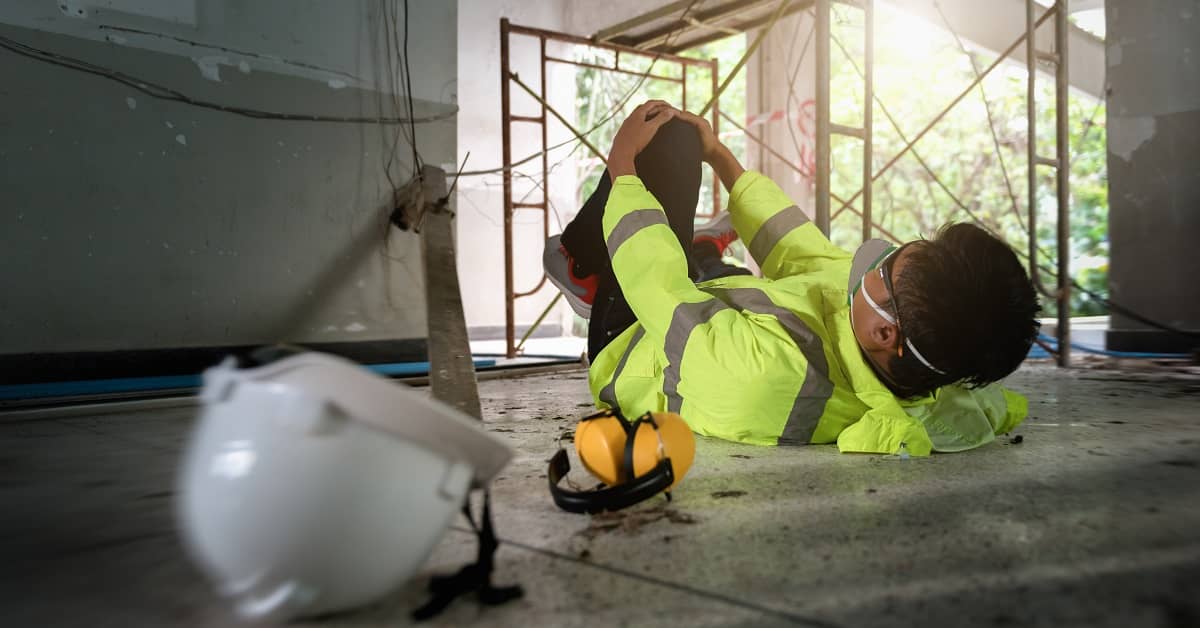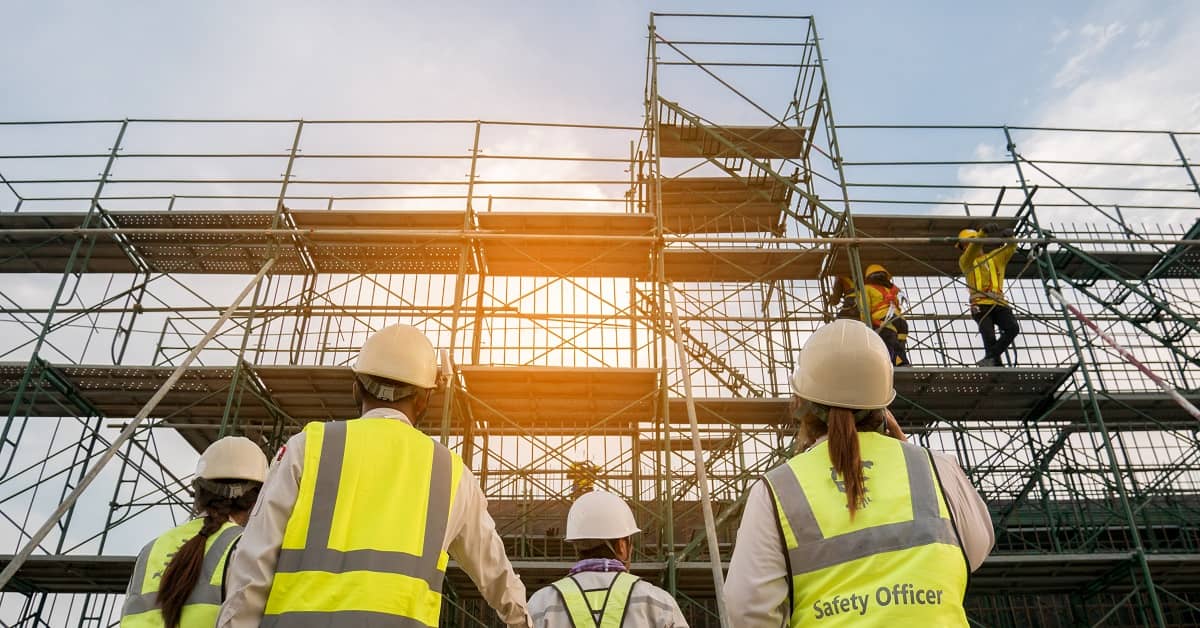Serving Construction Workers From New York Injured After Falling From Makeshift Scaffold
Construction is a dangerous way to earn a living. Workers performing jobs at heights are at particularly high risk, with falls representing the most common cause of accidental death on construction sites.
New York State labor law has unique provisions to protect workers who use scaffolding and other devices on the job. If you have been injured in a scaffold accident, you may have legal recourse beyond workers’ compensation.
The construction accident lawyers at Maggiano, DiGirolamo & Lizzi have decades of experience representing workers who have been injured on the job. Please call (212) 543-1600 today for a free consultation with our lawyers in New York City.

What Is the New York Scaffold Law?
Section 240 of the New York labor law is the state legislation that provides protections for construction workers and other workers who use scaffolding in the course of their jobs. The law requires that scaffolding be built to hold four times its maximum weight. In addition, scaffolding that rises more than 20 feet from the ground, is suspended from an overhead support, or built with stationary supports is required to have a safety railing that encloses the entirety of the structure.
As a vertical city, many types of scaffolding are employed in construction projects in and around New York City. Each type of scaffold is subject to different safety risks:
- Steel scaffolding: Metal scaffolding has become the standard on most work sites. Steel is sturdy, strong, and durable. However, the strength of the material does not mean scaffolds are immune from accidents. For example, tubular steel scaffolding is prone to collapse without sufficient cross bracing.
- Roller scaffolding: Also known as Baker scaffolding, scaffolds on rollers are designed to be moved from one part of a job site to another. However, it is crucial for workers, equipment, and materials not to be on the scaffold when it is being moved. When the scaffold is stationary, locks should be activated on the rollers to prevent rollaway accidents.
- Suspended scaffolding: Commonly used in painting, window washing, and building repair, suspended scaffolding must be anchored and balanced properly to ensure worker safety. If suspended scaffolding becomes unbalanced, workers may hang helplessly or suffer catastrophic falls from multiple stories.
- Ladder jack scaffold: A ladder jack assembly should not be used to perform work more than 20 feet off the ground. The ladders must be securely fastened and planking capable of supporting workers. Although they are set up near to the ground, workers can still suffer injuries in falls from ladder jack scaffolds.
- Wood scaffolding: Wooden planks on scaffolding must be able to support the weight of workers and materials and provide a smooth walking surface. Errors in construction increase the risk of falls and other accidents.
- Bosun’s chair: Also known as a boatswain’s chair, a bosun’s chair is used by a single worker to scale up and down a structure. The rope, harness, and safety belt in this device must meet minimum standards for safety. Failure of these components can be disastrous, sending the worker plummeting to the ground.
NY Labor Law 240 applies to scaffolding and other devices used for working at heights. This includes equipment such as:
- Ladders
- Hoists
- Slings
- Ropes
- Staging
- Pulleys
- Hangers
- Blocks
- Irons
The New York Scaffold Law extends protections to construction workers performing a variety of different tasks, including erecting a structure, demolition, performing alterations, painting, cleaning, finishing, and more. Most contractors and owners of property (except for the “owners of one and two-family dwellings who contract for but do not direct or control the work”) are liable for scaffold accidents that occur on construction sites.
If you suffered a gravity-related injury on a construction site, it is in your best interest to contact a New York City scaffold accident lawyer as soon as possible to discuss your claim.

What Causes Scaffolding Accidents?
In addition to the New York Scaffold Law, those responsible for scaffolding must also abide by federal regulations. The Occupational Safety and Health Administration (OSHA) sets requirements for scaffolding, including construction, access, use, and fall protection.
Many scaffold accidents occur due to violations of NY labor law, OSHA regulations, and other industrial codes. The exact cause, however, may vary. Frequent issues that cause a scaffold to fail or workers to fall include:
- Negligent assembly or construction of the scaffold: Unfortunately, owners and contractors too often fall short of their duties under NY Labor Law 240. Many scaffold accidents occur because the responsible parties use inferior equipment, cut corners during construction, and/or fail to secure scaffolding.
- Defective components: The materials used to build scaffolding are a key factor in the strength and stability of the devices. Defects in the design or manufacture, as well as failure on the manufacturer’s part to warn of potential dangers, can increase the likelihood of a scaffold accident.
- Misuse: One of the most common errors in the use of scaffolding on a construction site is trying to move a scaffold with workers and equipment still on it. Doing so may seem like it will save time, but scaffolding is not designed to be moved with excess weight.
- Excess weight: The New York Scaffold Law requires owners and contractors to construct scaffolding that can hold, at minimum, four times its weight. If the scaffold is overloaded or fails to meet the weight-bearing requirements, the device may collapse or tip over, posing a serious risk of injury to workers.
- Slip and fall and trip and fall accidents: Workers may slip, trip, and fall on scaffolding and other devices for a variety of reasons. Spilled liquids may form on footholds and planks, creating a slipping hazard, or workers may trip on objects or parts of the scaffold. Negligent construction may also be a factor, as workers may slip or trip on parts of the scaffold that are improperly built or secured.
Not all scaffold accidents involve falls from heights or failure of the scaffolding. Workers on the ground may suffer injury as a result of objects that fall from scaffolding and other equipment, such as tools, materials, and more.
Who Is Liable for a Scaffold Accident?
The reason the New York Scaffold Law is unique is its assignment of strict liability to contractors and owners of property for erecting scaffolding that meets legal standards for safety. In effect, workers who are injured due to accidents involving scaffolding, ladders, and other devices can sue for damages whether or not negligence on the part of the owner, contractor, and/or another agent was a factor.
For years, construction companies, business owners, insurance carriers, and others have pushed for changes to NY Labor Law 240, claiming that the law represents an unfair burden. In reality, however, the Scaffold Law levels the playing field for workers.
Workers in construction and other injuries are often unaware of dangerous conditions on job sites. They may be tasked with doing their work on unsafe or defective scaffolding and other equipment.
Given both the devastating impact of falls on construction sites and the frequency with which such accidents occur, the New York Scaffold Law makes plain the duties of owners and contractors. It also provides workers with a much-needed avenue for recovering compensation.

Common Injuries in Scaffold Accidents
Contact our scaffold accident lawyers if you or a loved one suffered the following:
- Brain injuries
- Injuries to the back and neck (including the spinal cord)
- Orthopedic injuries, including broken bones, joint injuries, damage to soft tissue, etc.
- Crush injuries
- Impalement injuries
- Electrocution and burns (as a result of workers and/or scaffolding coming into contact with overhead electrical wires)
Depending on the circumstances of the scaffold accident, workers who are using scaffolding as well as those on the ground may sustain serious injuries (or even be killed). If you were injured or a loved one died in a construction accident involving scaffolding, a ladder, or other equipment, an experienced attorney can help you and your family pursue fair compensation.
Meet the Attorneys at Maggiano, DiGirolamo & Lizzi
What Compensation Can I Recover for a Scaffold Accident?
Although the majority of workers know what workers’ compensation is, many don’t know their rights if they get hurt at work. The workers’ compensation benefits you can claim after an on-the-job accident in New York include:
- Coverage of medical expenses related to a work injury
- Lost wage benefits (calculated as two-thirds of your average weekly wage multiplied by the percentage of disability based on your injury)
- Survivor benefits – covers funeral and burial costs up to certain limits; dependents of a worker killed on the job may qualify for weekly payments to replace lost wages
The workers’ compensation system helps to offset some of the financial burdens associated with a work-related injury or the loss of a loved one in an on-the-job accident. However, these benefits do not fully compensate workers and their families for their losses.
Fortunately, workers injured in scaffolding accidents in New York have additional recovery options. The liability established by Labor Law 240 gives injured workers the right to sue for damages resulting from a scaffold or ladder accident.
As with other types of personal injury claims, you may be able to recover compensation for the following losses in a claim against a contractor or owner:
- Current and future medical expenses
- All lost wages
- Loss of earning capacity
- Pain and suffering
- Disfigurement
- Disability
- Loss of enjoyment of life
- Wrongful death damages (if your loved one was killed in a scaffold accident, you and your family may be entitled to compensation for all funeral and burial expenses, current and future loss of wages and benefits, and more)
In strict liability claims, you do not have to prove the defendant(s) was/were negligent in order to recover damages. Rather, your right to recovery is based on (a) the defendant being responsible for erecting scaffolding and (b) the fact that you suffered injury or your loved one was killed in an accident related to the scaffolding.

What You Should Do After a Scaffolding Accident
Construction workers often find themselves outmatched when it comes to recovering compensation after a work injury. Filing a workers’ compensation claim can be challenging, and owners, contractors, and insurance companies will frequently dispute liability in claims involving scaffold accidents.
There are steps you can take immediately to protect your rights following a scaffold accident. Here is what you should do:
- Seek medical care. Most injuries from scaffold accidents are a medical emergency. You should dial 911, or ask one of your coworkers to make the call for you. It is important to get to the nearest emergency room as soon as possible.
- Notify your employer of the accident. You are required to provide notification to your employer, in writing, within 30 days of the accident. Failure to do so may bar you from receiving workers’ comp.
- File a claim with the Workers’ Compensation Board. In addition to notifying your employer of the accident, you should report the scaffold accident to the New York State Workers’ Compensation Board (WCB) as soon as possible. Claims must be filed with the WCB no later than two years after the accident.
- Attend all medical appointments. Except in the event of an emergency, your employer or its workers’ compensation insurance carrier controls which medical provider(s) you see after a work injury. Be sure to go to all scheduled appointments with the authorized provider, and tell the staff that you are receiving treatment for a work-related injury. Failure to keep up with your doctors’ recommendations concerning treatment, therapy, etc. may impact your workers’ compensation benefits as well as your ability to recover damages through other legal means.
- Keep records of all medical bills, out-of-pocket expenses, etc. Although your employer is responsible for the cost of medical care in a workers’ compensation claim, it is important to keep track of any and all costs you incur as a result of a scaffold accident. Bills and receipts are important documentary evidence in the event that your workers’ comp claim is disputed and/or you file a third party claim.
- Speak to an attorney. Scaffold accident claims can be complicated. If you file for workers’ compensation and/or believe that negligence was a factor in your injuries, it is in your best interest to seek legal counsel as soon as possible.
The lawyer you choose should be well-versed in both workers’ compensation law as well as the New York Scaffold Law. Your financial recovery depends on the ability of your attorney to pursue all options for fair compensation.
Contact Our Scaffold Accident Lawyers in New York Today
Construction accident claims are complicated. Injured workers and their families must contend with a variety of issues, from the pain and impairment of serious injuries to medical bills to loss of household income. Amid these challenges, handling a legal claim is the last thing you and your loved ones should have to deal with on your own.
The attorneys at Maggiano, DiGirolamo & Lizzi have decades of experience representing clients in scaffold accident cases and other claims involving construction site injuries. We have achieved millions of dollars in results on behalf of those who have been injured or lost loved ones in job-related falls, including recovery of damages under the New York Labor Law.
Please call (212) 543-1600 today for a free consultation. Our scaffold accident lawyers serve workers in New York City, West New York, and other areas of New York State.

















